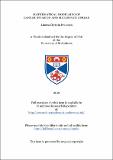Mathematical modelling of cancer invasion and metastatic spread
Abstract
Metastatic spread—the dissemination of cancer cells from a primary tumour with subsequent re-colonisation at secondary sites in the body—causes around 90% of cancer-related deaths. Mathematical modelling may provide a complementary approach to help understand the complex mechanisms underlying metastasis. In particular, the spatiotemporal evolution of individual cancer cells during the so-called invasion-metastasis cascade—i.e. during cancer cell invasion, intravasation, vascular travel, extravasation and metastatic growth—is an aspect not yet explored through existing mathematical models. In this thesis, such a spatially explicit hybrid multi-organ metastasis modelling framework is developed. It describes the invasive growth dynamics of individual cancer cells both at a primary site and at potential secondary metastatic sites in the body, as well as their transport from the primary to the secondary sites. Throughout, the interactions between the cancer cells, matrix-degrading enzymes (MDEs) and the extracellular matrix (ECM) are accounted for. Furthermore, the individual-based framework models phenotypic variation by distinguishing between cancer cells of an epithelial-like, a mesenchymal-like and a mixed phenotype. It also describes permanent and transient mutations between these cell phenotypes in the form of epithelial-mesenchymal transition (EMT) and its reverse process mesenchymal-epithelial transition (MET). Both of these mechanisms are implemented at the biologically appropriate locations of the invasion-metastasis cascade. Finally, cancer cell dormancy and death at the metastatic sites are considered to model the frequently observed maladaptation of metastasised cancer cells to their new microenvironments. To investigate the EMT-process further, an additional three-dimensional discrete-continuum model of EMT- and MET-dependent cancer cell invasion is developed. It consists of a hybrid system of partial and stochastic differential equations that describe the evolution of epithelial-like and mesenchymal-like cancer cells, again under the consideration of MDE concentrations and the ECM density. Using inverse parameter estimation and sensitivity analysis, this model is calibrated to an in vitro organotypic assay experiment that examines the invasion of HSC-3 cancer cells.
Type
Thesis, PhD Doctor of Philosophy
Collections
Items in the St Andrews Research Repository are protected by copyright, with all rights reserved, unless otherwise indicated.

